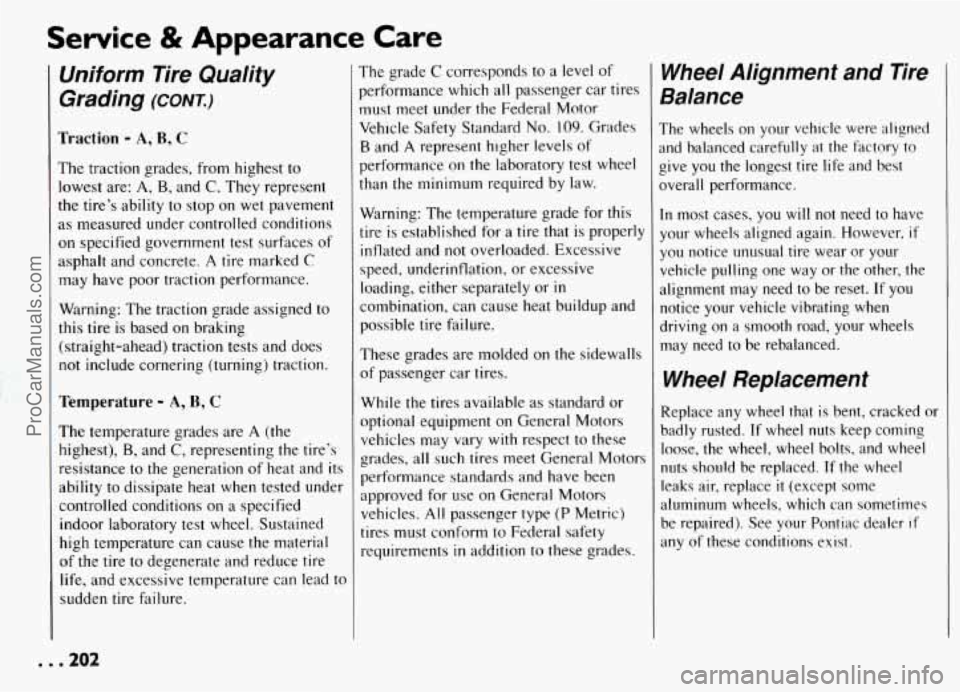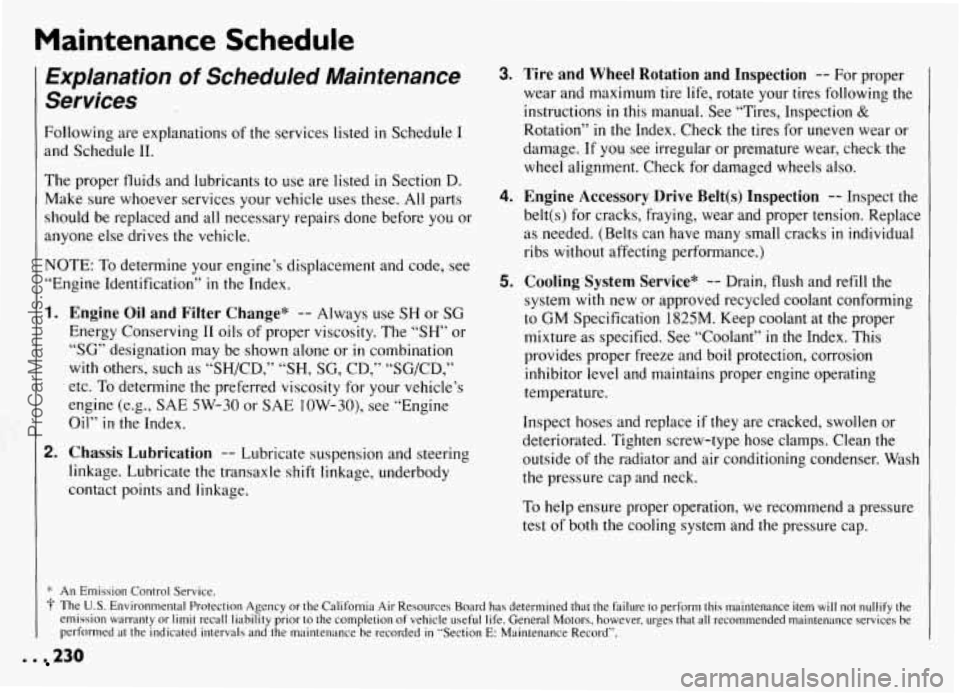1994 PONTIAC GRAND-AM wheel alignment
[x] Cancel search: wheel alignmentPage 203 of 274

Service & Appearance Care
Uniform Tire Quality
Grading
(CONT.)
Traction - A, B, C
The traction grades, from highest to
lowest are: A,
B, and C. They represent
the tire’s ability to stop on wet pavement
as measured under controlled conditions
on specified government test surfaces of
asphalt and concrete.
A tire marked C
may have poor traction performance.
Warning: The traction grade assigned to
this tire is based on braking
(straight-ahead) traction tests and does
not include cornering (turning) traction.
Temperature - A, B, C
The temperature grades are A (the
highest),
B, and C, representing the tire’s
resistance to the generation
of heat and its
ability to dissipate heat when tested under
controlled conditions on a specified
indoor laboratory test wheel. Sustained
high temperature can cause the material
of the tire to degenerate and reduce tire
life, and excessive temperature can lead to
sudden tire failure.
The grade C corresponds to a level of
performance which all passenger car tires
must meet under the Federal Motor
Vehicle Safety Standard
No. 109. Grades
B and A represent higher levels of
performance on the laboratory test wheel
than the minimum required by law.
Warning: The temperature grade for this
tire is established for a tire that is properly
inflated and not overloaded. Excessive
speed, underinflation, or excessive
loading, either separately or
in
combination, can cause heat buildup and
possible tire failure.
These grades are molded on the sidewalls
of passenger car tires.
While the tires available as standard or
optional equipment on General Motors
vehicles may vary with respect to these
grades, all such tires meet General Motors
performance standards and have been
approved for use on General Motors
vehicles. All passenger type
(P Metric)
tires must conform to Federal safety
requirements
in addition to these grades.
Wheel Alignment and Tire
Balance
The wheels on your vehicle were aligned
and balanced carefully
at the factory to
give you the longest tire life and best
werall performance.
[n most cases, you will not need to have
your wheels aligned again. However,
if
you notice unusual tire wear or your
vehicle pulling one way or the other, the
alignment may need to be reset. If you
notice your vehicle vibrating when
driving on a smooth road, your wheels
may need to be rebalanced.
Wheel Replacement
Replace any wheel that is bent, cracked or
badly rusted. If wheel nuts keep coming
loose, the wheel, wheel bolts, and wheel
nuts should be replaced. If the wheel
leaks air, replace
it (except some
aluminum wheels, which can sometimes
be repaired). See your Pontiac dealer
if
any of these conditions exist.
. . .202
ProCarManuals.com
Page 231 of 274

Maintenance Schedule
Explanation of Scheduled Maintenance
Services
Following are explanations of the services listed in Schedule I
and Schedule 11.
The proper fluids and lubricants to use are listed in Section D.
Make sure whoever services your vehicle uses these. All parts
should be replaced and all necessary repairs done before you or
anyone else drives the vehicle.
NOTE: To determine your engine’s displacement and code, see
“Engine Identification”
in the Index.
1.
2.
Engine Oil and Filter Change* -- Always use SH or SG
Energy Conserving I1 oils of proper viscosity. The “SH” or
“SG” designation may be shown alone or in combination
with others, such as “SH/CD,” “SH, SG, CD,” “SG/CD,”
etc. To determine the preferred viscosity for your vehicle’s
engine (e.g., SAE 5W-30 or SAE 10W-30), see “Engine
Oil”
in the Index.
Chassis Lubrication -- Lubricate suspension and steering
linkage. Lubricate the transaxle shift linkage, underbody
contact points and linkage.
3.
4.
5.
Tire and Wheel Rotation and Inspection -- For proper
wear and maximum tire life, rotate your tires following the
instructions
in this manual. See “Tires, Inspection &
Rotation” in the Index. Check the tires for uneven wear or
damage. If you see irregular or premature wear, check the
wheel alignment, Check for damaged wheels also.
Engine Accessory Drive Belt(s) Inspection -- Inspect the
belt(s) for cracks, fraying, wear and proper tension. Replace
as needed. (Belts can have many small cracks
in individual
ribs without affecting performance.)
Cooling System Service* -- Drain, flush and refill the
system with new or approved recycled coolant conforming
to
GM Specification 1825M. Keep coolant at the proper
mixture as specified. See “Coolant”
in the Index. This
provides proper freeze and boil protection, corrosion
inhibitor level and maintains proper engine operating
temperature.
Inspect hoses and replace if they are cracked, swollen or
deteriorated. Tighten screw-type hose clamps. Clean the
outside of the radiator and air conditioning condenser. Wash
the pressure cap and neck.
To help ensure proper operation, we recommend a pressure
test of both the cooling system and the pressure cap.
. . 230
ProCarManuals.com
Page 270 of 274

Stereo Sound Systems (see “Audio
Storage
Systems”) ................... lot
Armrest ..................... 82
Glove Box ................... 54
Passenger Side Cup Holder/
Storage Area ................ 85
Sunglasses Storage ............ 87
Storing Your Pontiac ............ 194
Stuck. If You Are
............... 167
Subscriptions .................. 25C
Sun Visors
..................... 84
Supplemental Restraint System (SRS)
........................ 21
Surge Tank Pressure Cap
......... 190
Tachometer .................... 92
rape Player (see “Audio Systems”)
rechnical Facts
& Specifications
Bulbs ...................... 217
Electrical Equipment.
Add-on .............. 107. 2 1 1
Fluid Capacities & Types . . 215. 216
Fuses
& Circuit Breakers ...... 212
Service Parts Edentification
Label ..................... 211
Vehicle Identification
Number (VIN) ............. 2 11
remperature Warning Light
........ 94
rheft
.......................... 52
rhermostat
.................... 190
l‘ilt Steering Wheel
.............. 71
Time. Setting the ............... 107
Tires
......................... 198
Buying New ................ 201
Chains
................. 143. 202
Flat. Changing
............... 162
Inflation
.................... 199
Inspection
& Rotation ......... 200
Loading
.................... 198
Pressure
.................... 199
Quality Grading
............. 201
Spare. Compact
.............. 167
Wear Indicators
.............. 192
Wheel Alignment and
Tire Balance ............... 202
Wheel Replacement
.......... 202
When to Replace Wheels
...... 202
Winter Driving. and Tires
...... 136
Top Strap ...................... 33
Torque Lock
.................... 68
Towing a Trailer
................ 141
Towing Your Pontiac
............ 152
Trailer Towing
................. 139
Maintenance ................ 146
Parking on Hills
............. 145
Trailer Brakes
............... 143
Driving with a Trailer ......... 144
Transaxle. Automatic (see “Automatic
Transaxle. Manual (see “Manual
rransmission. Automatic (see
Transaxle”)
Transaxle”)
“Automatic Transaxle”)
Transmission. Manual (see “Manual
Trip Odometer .................. 92
Trunk
......................... 53
Trunk Light
.................... 80
Trunk Release. Remote ........... 53
Turn Signal Indicator
............. 73
Turn Signal/Multifunction Lever
.... 78
Cruise Control ................ 74
Headlight Highbow Beam
...... 78
Turn Signal & Lane Change
Indicator ................... 73
Underbody Maintenance ........ 209
Unleaded Gasoline
.............. 173
Upholstery Care
................ 205
Upshift Indicator Light
......... 65. 99
Urban Driving
................. 132
Variable Effort Steering ......... 125
Vehicle “Break-In” Period
......... 54
Vehicle. Control
of a ............ 122
Vehicle Identification Number
(VIN) ....................... 211
Vehicle Loading
................ 197
Vehicle Storage
................ 194
Ventilation (see “Comfort
Controls”) ................... 103
VIN
......................... 211
Visors. Sun
..................... 84
Visor Vanity Mirror
.............. 84
Voltmeter ...................... 97
269
Transaxle” )
d
ProCarManuals.com
Page 271 of 274

warning Flashers. Hazard ....... 148
Warning Lights
.................. 93
ABS
........................ 99
Air Bag Readiness
............ 22
Battery
...................... 97
Brake
....................... 98
Charging System
.............. 97
Check Gauges
............... 100
Coolant Temperature
.......... 94
Fasten Belts
.................. 16
Low Coolant ................. 95
Oil
......................... 95
Safety Belt
.................. 16
Service Engine Soon
.......... 100
Upshift Indicator
............ 65. 99
Washer. Windshield .............. 82
Weight
Gross Axle Rating (GAWR) .... 197
Gross Vehicle Rating (GVWR)
. . 197
Wheel Alignment
& Tire Balance . . 202
Wheel Covers.
How to Remove .... 163
Wheel Nuts
.................... 163
Wheel Nut Torque
.............. 166
Wheel Replacement
............. 202
Defogging .............. 102. 104
Power
...................... 72
Standard
.................... 72
Windshield Washer .............. 82
Windows
Windshield Washer Fluid ......... 191
Windshield Wiper Blade
Replacement ................. 196
Windshield Wipers
............... 81
Cleaning
................... 207
Controlled Cycle
.............. 81
Winter Driving
................. 136
Driving on Snow or Ice
........ 136
If Your Car is Stuck in Deep
Snow ..................... 138
If You’re Caught in a Blizzard
. . 137
Wrecker Towing
................ 152
... 270
ProCarManuals.com